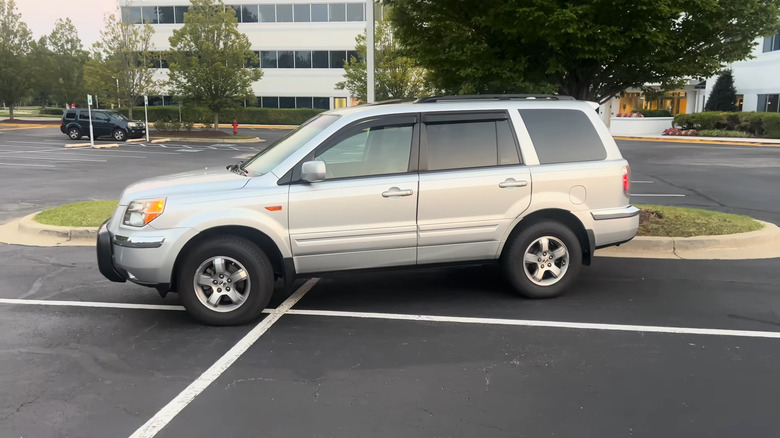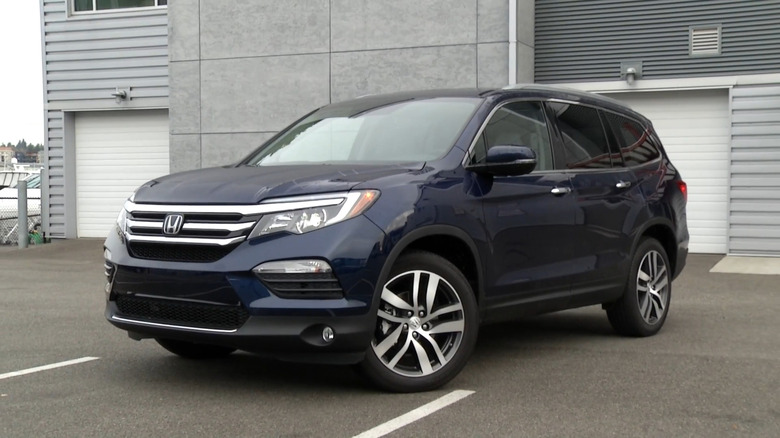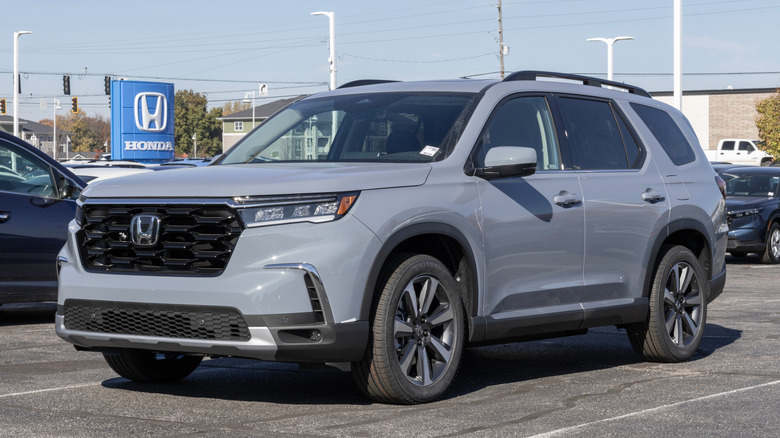Every Honda Pilot Generation Ranked Worst To Best
Over the years, Honda has given us some of the most well-rounded cars on the road across almost all mainstream segments. There aren't many brands that have more of a presence on U.S. roads, with only the likes of Toyota, Ford, and Chevrolet having better-selling nameplates so far this year. Considering the long-standing and ever-growing popularity of SUVs, it's no surprise to see Honda offer many of these vehicles at different ends of the segment, with the Pilot being the largest of the bunch moving into 2026.
While it's one of the best three-row SUVs you can buy at the moment, the Pilot isn't a new model, debuting in 2003. Since then, the SUV has gone through four generations, including the current version, each receiving a fair share of updates and improvements. With the newest models being quite expensive, looking towards the used market is a great choice to save some money, as older models don't lose out by much when it comes to overall performance and practicality, if you're willing to sacrifice the latest tech and safety features. Here's each of the Honda Pilot generations, ranked from worst to best.
First generation (2003-2008)
All other generations of the Honda Pilot are ranked higher than the first generation, but that doesn't mean the earliest years should be avoided entirely. Rather, certain model years fall short compared to newer models, which is somewhat expected, as some are over 20 years old now. The Pilot's launch in 2003 was met with widespread praise, but today, it looks to be one of the model years that hasn't aged as well.
Under the hood, the first-generation Pilot was powered by a 3.5L V6, producing 240 horsepower and 242 pound-feet of torque. The 2005 Pilot's output increased to 255 horsepower, the same as the second generation's, so the earliest models don't lag in power. Inside, the differences are more noticeable, with its standard LCD feeling rather dated, to say the least. You could get a seven-inch screen if you go for a 2006 model onwards, though, when equipped with the navigation package.
When it comes to reliability, however, the early Pilots fall short when compared to the rest. On CarComplaints.com, the 2003 and 2005 model years have faced the most issues according to owners, with the ignition switch and transmission being major cruxes for the 2003 model. Transmission leaks take the unwanted crown for the 2005 model's most reported issue. On the contrary, the later first-gen models don't have anywhere near as many complaints, so a 2006-2008 Honda Pilot would still be a solid choice if you want to save some money.
Third generation (2016-2022)
Skipping past the second generation of the Honda Pilot, the third generation of the Japanese SUV got off to a rough start, to say the least. On the outside, the changes were drastic. The 2016 model's philosophy ditched the boxy styling of the previous-gen models for more modern, smoother features throughout the shell. The updates were also prevalent inside, with a redesigned dashboard and center console to match the outside. 2016 was also the first year to get the manufacturer's Honda Sensing safety suite.
For performance, the Pilot received a new and improved 3.5L V6 engine, increasing the SUV's output to 280 horsepower and 262 pound-feet of torque. A new automatic transmission was also introduced, which happens to be the main area that drops the second generation down the rankings. An issue most commonly reported by owners of the 2016 model, the transmission would often jolt, particularly when accelerating. Owners of the 2016, 2017, and 2019 Pilots also encountered some electronic issues.
However, if you stay towards the latter model years of the third generation, the outlook is far better. You will have to spend a little more money for an early 2020s model, but overall complaints are far lower for the later third-generation Honda Pilots compared to the beginning of its run.
Fourth generation (2023-Present)
On paper, the newest generation of the Honda Pilot is the best when it comes to standard features, which shouldn't be a surprise to anyone. For the 2023 model year Pilot, Honda redesigned the vehicle from the ground up to remain one of the most practical SUVs in the mid-size segment, which it certainly is. Leaning back into the boxy, hard-lined design style that featured in the second generation of the nameplate, it's easy to say that the latest Pilot looks the best out of the bunch. Once again featuring a 3.5L V6 engine, the 2023 Pilot also sees a slight increase in performance, reaching 285 horsepower over the third-gen's 280 horsepower.
The modern refresh carries on inside, with the center screen now measuring seven inches as standard. Overall cargo volume is a huge point scorer, with up to 111.8 cubic feet behind the first row if you go by the SAE J1100 plus standards. All the best features are definitely a bonus for the fourth-gen models. However, the current MSRP for the 2025 Pilot is $40,200. Earlier models still offer solid practicality, performance, and reliability for a much lower price point. According to KBB, 2023 models go for an average of $29,916 in the SUV's base guise, but that's still notably higher than older years.
Second generation (2009-2015)
The older second-generation models stand out as fantastic options if you want to save even more money. Before getting into the specifics about the 2009 to 2015 Pilots, it's important to cover a primary issue that some owners have faced. The variable cylinder management system has caused some pain for second-gen Pilot owners over the years, with it leading to further issues like increased oil consumption, spark plug fouling, and vibration. If you disable the VCM, which can easily be done using a disabler or 'muzzler', owners have reported the issues subsiding. This doesn't affect all second-gen Pilots, but it means there are certain models you should avoid.
Outside of the VCM, however, the Honda Pilots produced from 2009 to 2015 often find themselves highly recommended by reviewers and owners alike. Going off the owner reviews submitted on Cars.com, the second-gen Pilot doesn't drop below an average of 4.5 out of five stars, with comfort, value, and reliability often cited as the strong points. Unsurprisingly, these model years were powered by a 3.5L V6, this time producing 250 horsepower and 253 pound-feet of torque. Behind the first row of seats, the 2009 Pilot offers 87 cubic feet of space, putting it on par with the standard measurement in the latest 2025 model. According to KBB, the 2009 Pilot goes for just $4,722, with the last second-gen 2015 model still only costing around $8,678.
Methodology
To rank the Honda Pilot generations from worst to best, we first looked at the essentials, including performance, practicality, standard features, and reliability, to see how they hold up against each other. We then gathered information from owner reviews of the model years within each respective generation, alongside data collected by various outlets, to see which models are most recommended.





